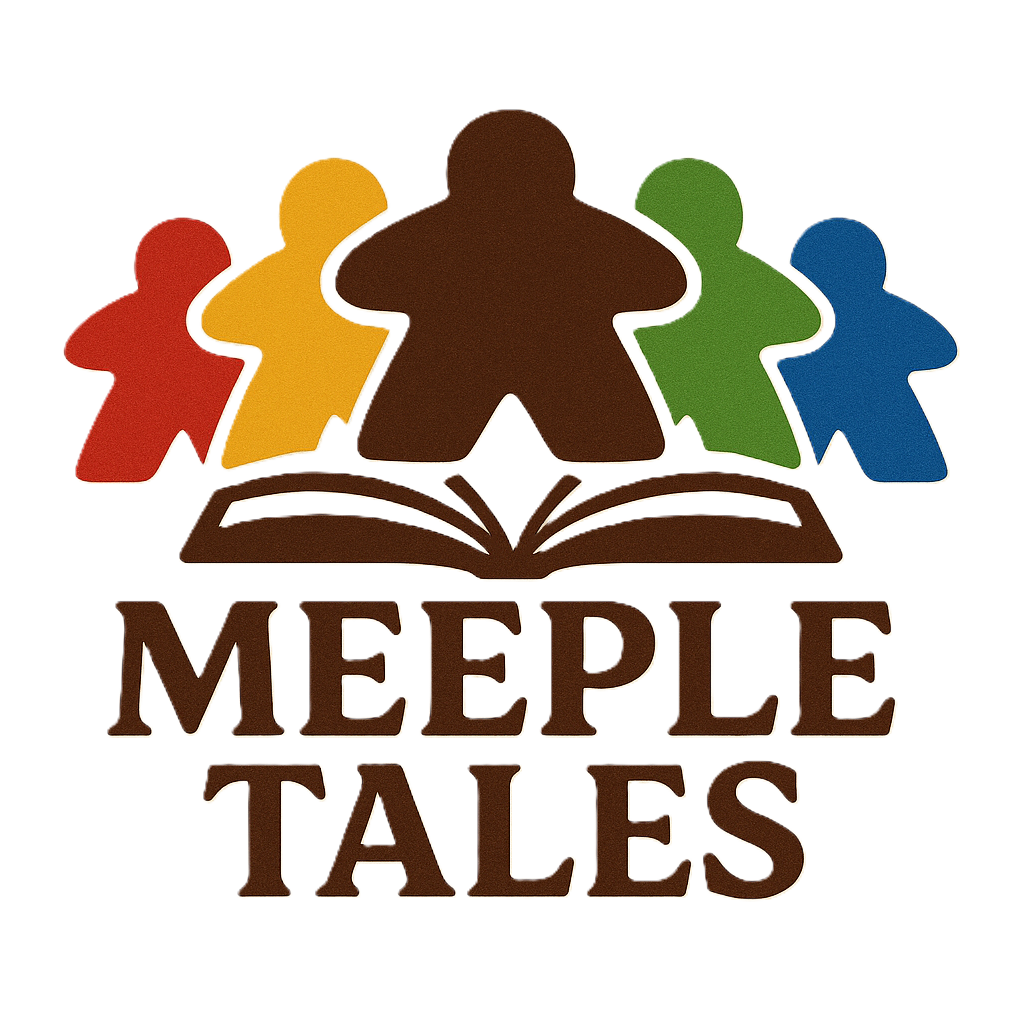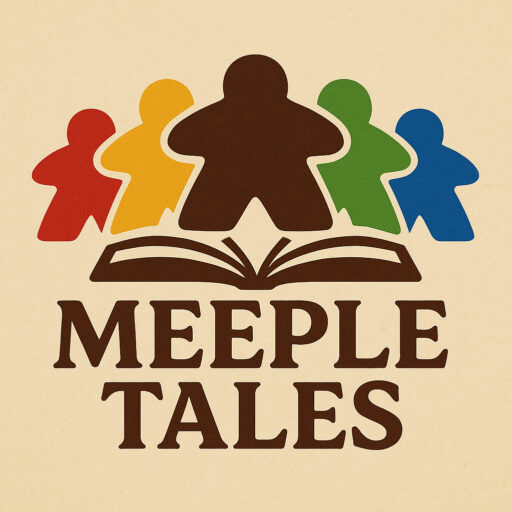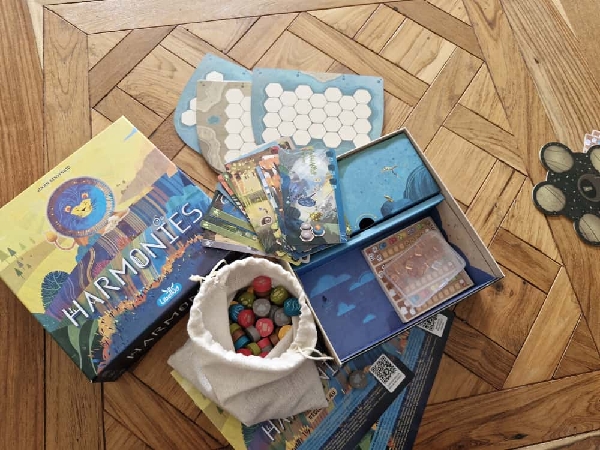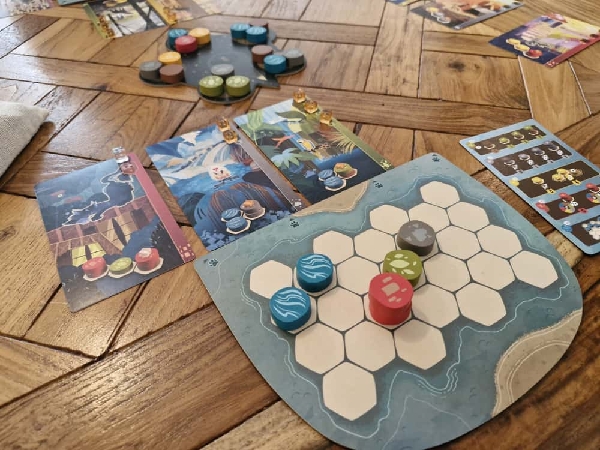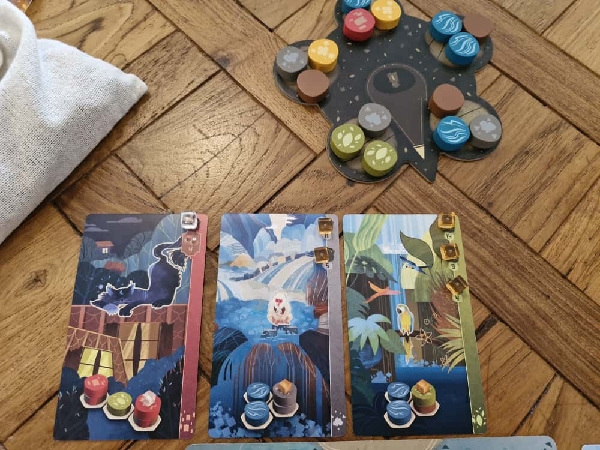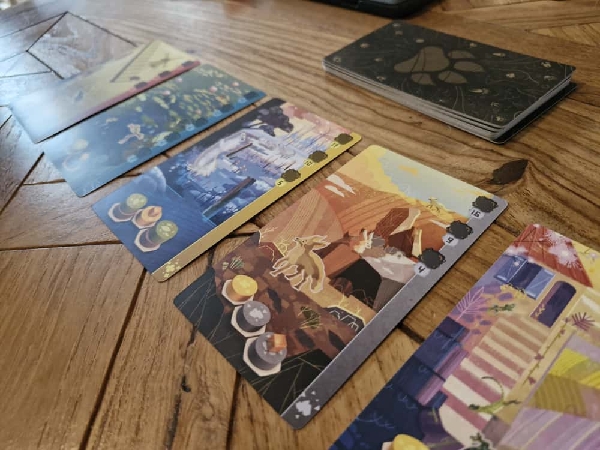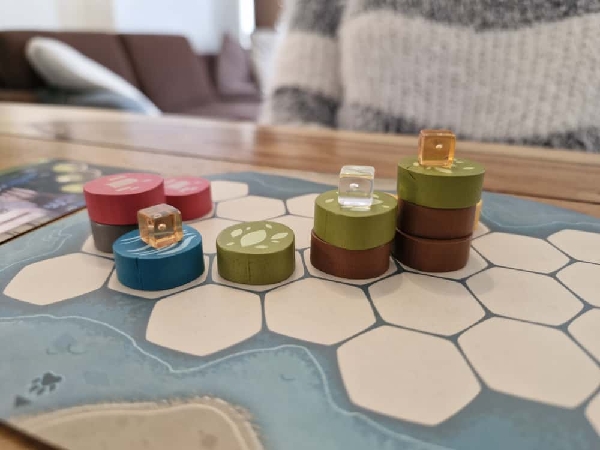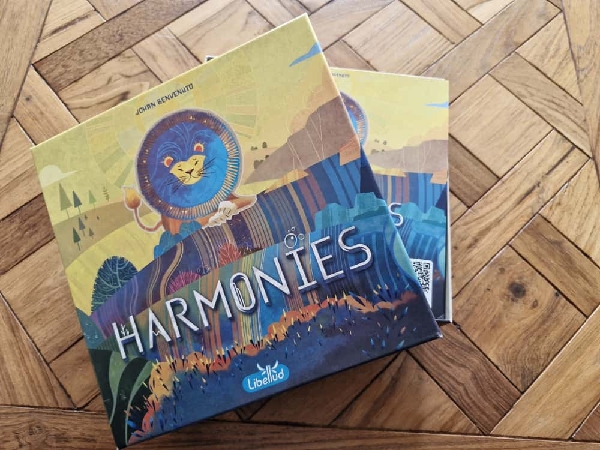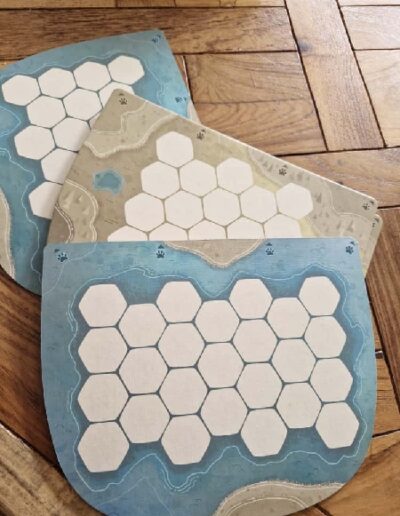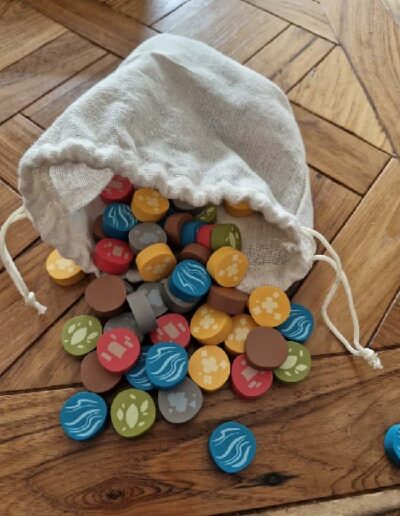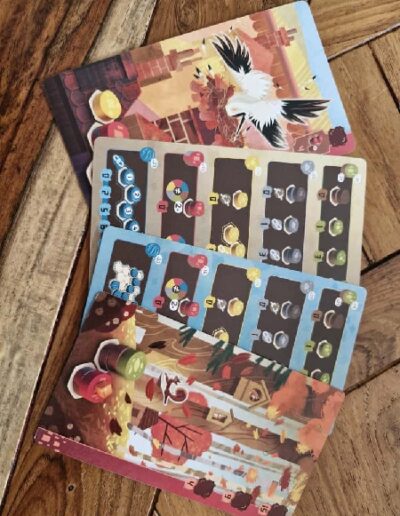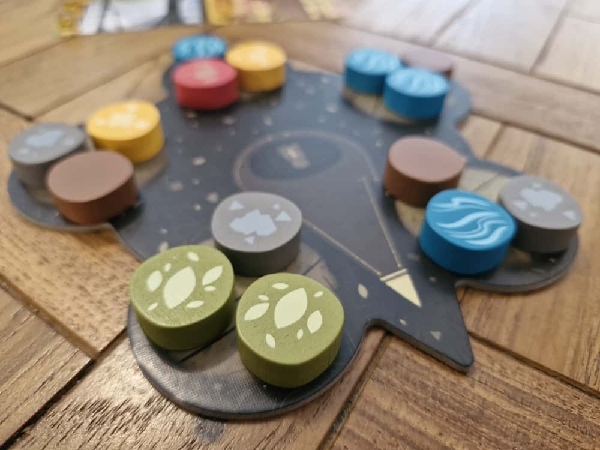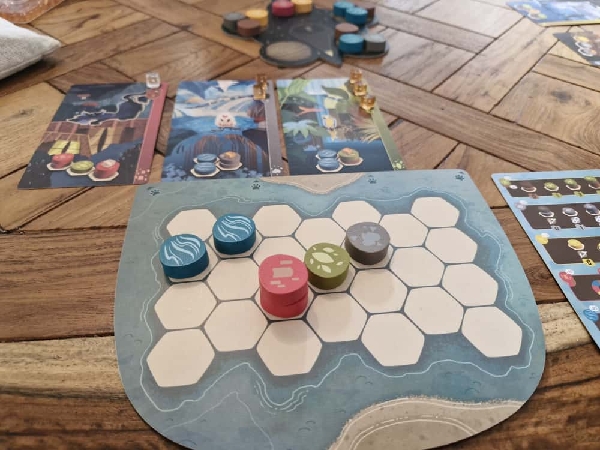Aantal spelers: 2-4
Speelduur: 30-45 minuten
Leeftijd: Vanaf 8 jaar
Auteur: Johan Benvenuto
Uitgever: Libellud
Jaar: 2024
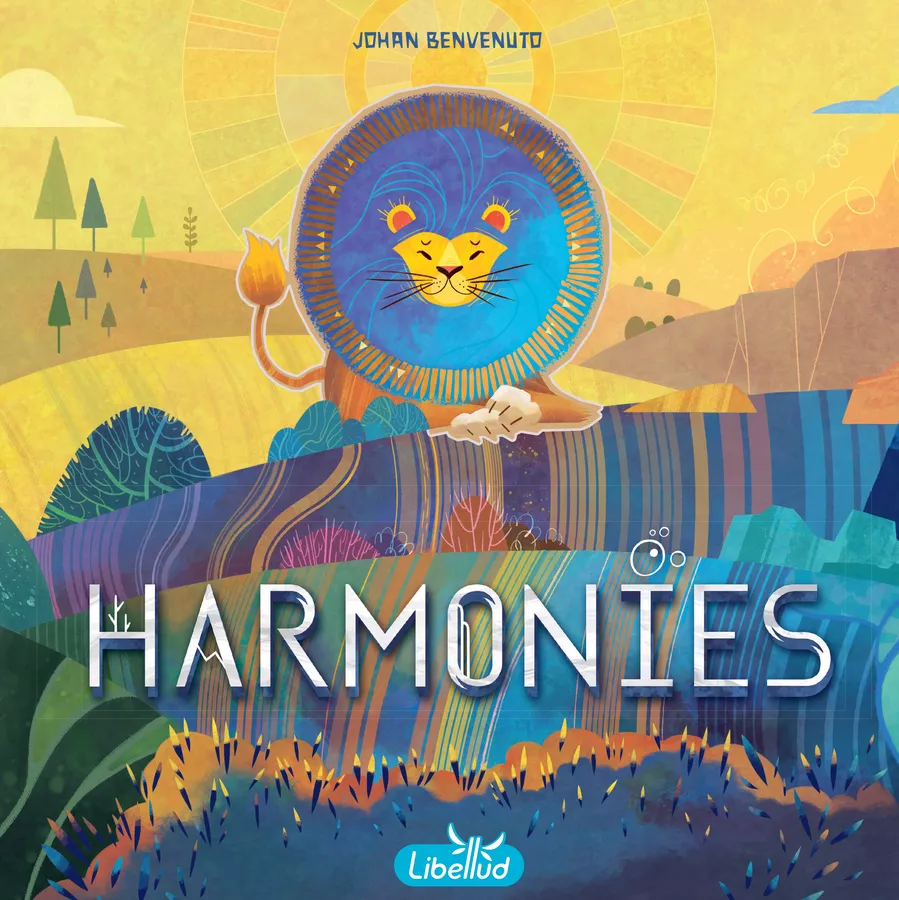

Dit is een herpublicatie van een review die ik eerder schreef voor bordspelwereld.nl
Harmonies voelt een beetje als een liefdesbaby tussen verschillende spellen. Zo’n samensmelting die eens niet voelt als “meer van hetzelfde” maar als een goede combi van mechanismes die complementair aan elkaar blijken. Hoewel het spel zijn naam niet te danken heeft aan het harmonieus samengaan van deze mechanismes, dekt dat wel de lading. Met een drafting systeem, a lá Azul, het vervullen van patroonopdrachten a la Reef en de prachtige vormgeving van Maëva da Silva, die je kan kennen van When I Dream en Mysterium Park, haal je een ware parel in huis die perfect in harmonie is.
Toegegeven, abstracte puzzels moeten wel in je straatje liggen, even als het werken aan patronen op je eigen speelbordje. Want dat is precies wat we bij Harmonies gaan doen: al draftend verzamel je stenen die verschillende elementen der aarde vertegenwoordigen en waarmee je prachtige landschappen gaat vormen. Doel is om deze elementen zo goed mogelijk in harmonie op je bordje te plaatsen en zo patronen en opdrachten te vervullen en de meeste punten te verzamelen. Wie de meeste punten heeft gehaald, heeft de beste harmonie in diens landschap en tussen patronen en wint het spel.
Iedere speler krijgt zijn eigen speelbord, die tweezijdig is, met elke kant een eigen scoringsmechanisme voor het element water. Je beslist vooraf welke kant je gebruikt. In het midden liggen kleine fabriekjes op een centraal bord zoals je deze van Azul kent met hierop ieder drie stenen.
Hoe speel je het spel?
Een beurt is vrij simpel
- Je mag een opdracht pakken uit de markt. Bij je eigen bordje heb je plaats voor maximaal vier opdrachten. Dit kan ook aan het einde van je beurt.
- Je pakt de steentjes uit een van de vakjes in de markt. Dit zijn er altijd drie. Je laat niets liggen
- Je plaatst de steentjes op je bord
- Je handelt eventueel vervulde patronen en kaarten af
- Je vult de markt weer aan. Dit doe jij met zowel de steentjes als de kaarten.
Het leuke aan dit spel is dat je continu de keuze moet maken in hoe je steentjes te plaatsen.
Want:
- Elke opdrachtenkaart scoor je niet één keer, maar meerdere keren. Een gekozen patroon moet afhankelijk van de kaart dus vaker voorkomen op je bordje.
- Wanneer je een patroon afwerkt, plaats je een edelsteen op het steentje, zoals afgebeeld op de kaart. Op elke steen kan maar één edelsteen. Die steen kan je dus niet meer gebruiken om nog andere kaarten te scoren en combinaties te maken waarbij de steen op dezelfde steen geplaatst moet worden of om op door te bouwen/stapelen.
- Hoe vaker je het patroon scoort, hoe meer de kaart waard is. Na het nemen van een kaart uit de markt leg je een aantal edelstenen op je kaart gelijk aan het aantal vakjes. Deze werk je van onder naar boven af. Elk nieuw vrijgespeeld vakje heeft een hogere waarde. Aan het einde van het spel scoor je de hoogste waarde. Op iedere kaart zijn de waardes en het aantal keren score anders.
- Aan het einde scoor je niet alleen de punten van je opdrachtenkaarten, maar óók nog het eindresultaat van je hele bordje, waarbij alle elementen in jouw landschap hun eigen telling hebben. (Die soms de te behalen kaarten in de weg zitten en andersom, maar elkaar ook kunnen versterken!). Hierbij is de score van het water variabel, afhankelijk van welke kant van de spelersbordjes je gebruikt.
Het scoren van jouw landschap
Geel staat voor het veld. Deze scoort lekker, want elk afzonderlijke combinatie van minimaal twee elementen veld levert al vijf punten op. Het verraderlijke: veld wordt nóóit hoger, dan maar één steentje, wat dus snel zorgt voor een vol bord. Ook is het zo dat een gebied niet meer waard is bij meer stenen. Of het nou drie of zeven stenen groot is, je scoort per geel gebied vijf stenen.
Groen staat voor een boom. Deze scoort afhankelijk van de hoogte één, drie, of zeven punten. Wanneer je een boom hoger wilt maken, speelt je eerst één of twee keer bruin, de stam. Wanneer je een groen steentje direct op het bord legt, kan deze boom dus niet meer groeien. Je plaatst namelijk nooit steentjes onder een reeds geplaatst steentje, enkel er op.
Grijs staat voor de bergen/rotsen. Deze scoren individueel gezien hetzelfde als bomen. Maar hebben wel de vereiste altijd aan een andere berg te moeten grenzen. Een losse berg is dus niets waard. Van bergen zijn alle steentjes grijs.
Rood. Dit zijn gebouwen. Gebouwen zijn altijd twee hoog en kunnen als fundament een bruine, grijze of rode tegel hebben. Gebouwen scoren vijf punten, zodra ze omringd worden door minimaal drie verschillende elementen. Bij minder kleuren zijn ze waardeloos.
Blauw is het water en de tegels vormen rivieren en meertjes. Op de beige kant van het bord scoor je met een zo lang mogelijke rivier bestaande uit aaneengesloten blauwe steentjes. Op de blauwe kant van het bord probeer je zo slim mogelijk eilandjes te creëren door delen van het wordt middels water af te sluiten. Elke afzonderlijk gebied scoort vijf punten.
Natuurgeesten
Voor de gevorderde speler is er nog een extra module: De natuurgeesten. Een natuurgeest is een individuele kaart met een relatief wat moeilijker patroon (dan wel om te maken, dan wel om op je bordje te hebben voor de rest van het spel), die als hij behaald is een extra scoringsmogelijkheid unlocked. Deze is persoonsgebonden en geldt dus alleen voor de speler met de kaart en alleen als het patroon is voldaan. Zolang hij niet is voldaan neemt hij één plek in beslag van de vier plaatsen die je hebt voor opdrachtkaarten.
Einde van het spel
Wanneer een speler nog max twee open vakjes heeft op zijn bordje, betekent dit dat de huidige ronde wordt afgemaakt en het spel daarna stopt. Om de gehele score te bereken tel je de kaarten van je opdrachtenkaarten, je landschap en eventueel de natuurgeesten bij elkaar op.
Wat ik vind?
Ik ben fan. Ik kan er enorm van genieten als een ogenschijnlijk zeer eenvoudig mechanisme zoveel diepgang blijkt te hebben. De grote hoeveelheid (meer dan prachtige!) kaarten zorgt continu voor een ander spel, dat zeker wanneer de natuurgeesten ook in het spel zijn steeds voor nieuwe uitdagingen zorgt, te meer omdat je het zult moeten doen met de steentjes die je voor handen krijgt. Het is een continue afweging of je steentjes strategisch plaatst op basis van de telling van het bord, of op basis van de opdrachten die je al hebt liggen of die voor handen zijn. Het is een leuke puzzel om die opdrachten te kunnen combineren en met zo min mogelijk steentjes zoveel mogelijk van die kaarten te behalen, waarbij je ook nog rekening moet houden met het aantal keren dat je een patroon dient te maken, maar je óók nog wilt dat je landschap/bordje op zichzelf wat waard is. Én waarbij het plaatsen van de edelstenen boven op de steentjes ook nog eens een echte handicap kan zijn, omdat dat sommige combinaties en het doorbouwen op bergen onmogelijk maakt. Er zit een uitdaging in het optimaliseren van de mogelijkheden die je krijgt. Het combineren is helemaal niet zo makkelijk als het lijkt. En dat maak het spel aan sich iets minder zoet dan de vormgeving je misschien doet vermoeden.
Kunnen we het asjeblieft nog één keer hebben over de prachtige vormgeving. Ik heb zelf niet heel veel spellen in de kast waar Maëva da Silva haar aandeel in heeft gehad. Maar een kijkje in haar portfolio leert mij wel dat dit absoluut een van haar meesterwerkjes is. Het is een overdaad aan kleur die nooit als te veel of bombastisch voelt of het spel te kort doet. De prachtige natuurwereld die zij weet te schetsen doet dit spel de abstractie ontstijgen om je vervolgens alsnog mee te nemen in een prachtige fantasiewereld zonder al te sprookjesachtig of feeëriek te worden, zoals heel veel natuurspellen dat wel doen. (Wat ik overigens ook helemaal niet erg vind). Ook hierin schuilt een wonderbaarlijke harmonie die voor mij precies klopt.
Natuurlijk kunnen we een heel gesprek gaan voeren of in dit spel thema en mechanisme aan elkaar zijn verbonden. Nee, natuurlijk niet. En vaak is dat een storende factor voor spelers. Wanneer een thema teveel op het mechanisme geplakt is, missen spelers vaak de connectie. Maar dit spel bevat voor mij simpel weg te veel plussen dat ik tijdens het spelen (en geloof me, dat waren een héleboel potjes) me hier nog nooit aan heb gestoord. Geen moment. Ik word vooral blij. Héél blij!

Harmonies
Players: 2-4
Time: 30-45 minutes
Age: 8+
Author: Johan Benvenuto
Publisher: Libellud
Year: 2024


Harmonies feels a bit like a love baby between different games. Such an amalgamation that for once doesn’t feel like “more of the same” but like a good combo of mechanisms that turn out to be complementary to each other. Although the game does not owe its name to the harmonious blending of these mechanisms, it sure could have! With a drafting system like Azul, fulfilling pattern assignments a la Reef and the beautiful design by Maëva da Silva, who you might know from When I Dream and Mysterium Park, you get a true gem which is perfectly in harmony.
I must admit, abstract puzzles have to be right up your alley, as does working on patterns on your own game board. That is exactly what we are going to do in Harmonies: while drafting, you collect stones that represent different elements of the earth and with which you will form beautiful landscapes. The goal is to place these elements as well as possible in harmony on your board to fulfill patterns and assignments and collect the most points. Whoever gets the most points, has the best harmony in their landscape and between patterns and wins the game.
Each player gets their own game board, which is two-sided, with each side having its own scoring mechanism for the element of water. You decide in advance which side to use. In the middle are small factories on a central board as you know it from Azul with three stones on each.
How do you play the game?
A turn is quite simple:
- You may take an assignment from the marketplace. At your own board, you have room for up to four assignments. This can also be done at the end of your turn.
- You pick the stones from one of the boxes in the market. These are always three. You do not leave anything lying around
- You place the stones on your plate
- You handle any fulfilled patterns and cards
- You replenish the market. You do this with both stones and cards.
The nice thing about this game is that you constantly have to make the choice in how to place your stones. Because:
- You don’t score each assignment just once, but several times. So a chosen pattern must appear more often on your board depending on the card.
- When you finish a pattern, place a gemstone on the stone, as shown on the card. Only one gemstone can be placed on each stone. So you can no longer use that stone to score other cards and make combinations where the stone must be placed on the same stone or to build/stack on.
- The more often you score the pattern, the more worthy the card is. After taking a card from the market, you place a number of gems on your card equal to the number of squares. You work these from bottom to top. Each newly cleared square has a higher value. At the end of the game you score the highest value. On each card, the values and number of times score are different.
- At the end you score not only the points of your assignment cards, but also the end result of your entire board, where all the elements in your landscape have their own count. (Which sometimes get in the way of the cards to be achieved and vice versa, but can also reinforce each other!). Here the water score is variable, depending on which side of the player board you use.
Scoring your landscape
Yellow represents field. This one scores nicely, because every single combination of at least two elements field already scores five points. The tricky thing: field never gets higher, than just one stone, which therefore quickly makes for a full board. Also, an area is not worth more with more stones. Whether it is three or seven stones in size, you score five stones per yellow field.
Green represents a tree. This scores one, three, or seven points depending on its height. When you want to make a tree taller, you first play brown, the trunk, once or twice. When you place a green stone directly on the board, this tree can no longer grow. This is because you never place stones under an already placed stone, only on top of it.
Gray represents mountains/rocks. These individually score the same as trees, but do have the requirement of always being adjacent to another mountain. Thus, a separate mountain is worth nothing. Of mountains, all stones are gray.
Red. These are buildings. Buildings are always two high and can have a brown, gray or red tile as their foundation. Buildings score five points as soon as they are surrounded by at least three different elements/colors. With fewer colors, they are worthless. At the end this can also be a trunk part/ brown stone a.k.a. unfinished tree.
Blue is the water and the tiles form rivers and lakes. On the beige side of the board, you score with the longest possible river consisting of contiguous blue tiles. On the blue side of the board, you try to create islands as cleverly as possible by closing off parts of the area with water. Each individual area scores five points.
Nature Spirits
For the advanced player, there is an additional module: the nature spirits cards. A nature spirit is an individual card with a relatively somewhat more difficult pattern (either to make or to have on your board for the rest of the game), which when achieved unlocks an additional scoring opportunity. This is personalized and therefore applies only to the player with the card and only if the pattern is fulfilled. Until it is fulfilled it takes up one spot of the four spots you have for assignment cards.
End of the game
When a player has max two open squares left on his board, it means that the current round is finished and the game ends after that. To calculate the entire score, add up the points from your assignment cards, your landscape and any nature spirits.
What do I think?
I am a fan. I can really enjoy it when a seemingly very simple mechanism turns out to have so much depth. The large amount of (more than beautiful!) cards continuously creates a different game, which, especially when the nature spirits are also in play, always provides new challenges. Especially since you will have to make do with the stones you get in front of you. It is a constant balancing act whether to strategically place stones based on the count of the board, or based on the assignments you already have or that are at hand. It is a nice puzzle to be able to combine these assignments and obtain as many of the cards as possible with as few stones as possible, where you also have to take into account the number of times you need to make a pattern, but also want your landscape/board to be worth something on its own. And where placing the gems on top of the tiles can also be a real handicap, as it makes some combinations and building on mountains impossible. There is a challenge in optimizing the possibilities you get. Combining is not at all as easy as it seems. And that makes the game to itself a little less sweet than the design might lead you to believe.
Can we please talk one more time about the beautiful design. I don’t have very many games in my cabinet myself that Maëva da Silva has had her share of. But a look at her portfolio tells me that this is definitely one of her masterpieces. It’s an excess of color that never feels like too much or bombastic or shortchanges the game. The beautiful natural world she manages to sketch makes this game transcend abstraction to then still take you into a beautiful fantasy world without becoming too fairy-tale or fairy-like, as a lot of nature games do. (Which, by the way, I don’t mind at all). There is a wonderful harmony in this as well that is exactly right for me.
Of course, we could go into a whole conversation about whether in this game theme and mechanism are connected. No, of course they’re not. And often that is a distracting factor for players. When a theme is stuck too much on the mechanism, players often miss the connection. But this game simply contains too many pluses for me that while playing (and believe me, that was a heck of a lot of games) this never bothered me. Not for a moment. Most of all, I get happy. Very happy!
